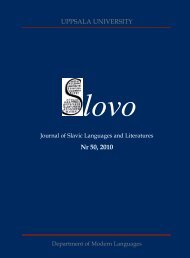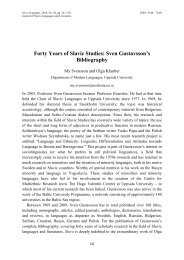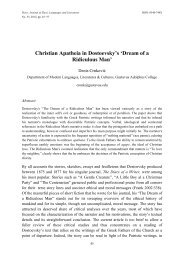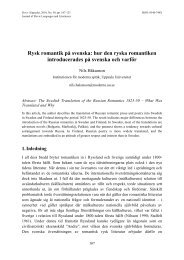UPPSALA UNIVERSITY - Index of - Uppsala universitet
UPPSALA UNIVERSITY - Index of - Uppsala universitet
UPPSALA UNIVERSITY - Index of - Uppsala universitet
- No tags were found...
You also want an ePaper? Increase the reach of your titles
YUMPU automatically turns print PDFs into web optimized ePapers that Google loves.
Slovo (<strong>Uppsala</strong>), 2010, No. 51Journal <strong>of</strong> Slavic Languages and Literaturesjuncture in the research on Bulgarian syntax. In several works (Bajčev & Videnov1988:219–245; Angelova 1988a, 1988b; Likomanova 1996; Ničeva 1985; Yosifova1987, 1999; Barakova 2003 etc.), the ultimate goal is to determine the differences inthe syntactic parameters between spoken and written Bulgarian; however, theemphasis is only on spoken samples. The differences are interpreted in terms <strong>of</strong>frequency, in that the spoken language is spontaneous, contextual and produced in realtime. The spoken language is thus characterized as containing more elicitation <strong>of</strong>verbal and nominal components in mono-predicative syntactic constructions, andshowing a preference for asyndetical chaining <strong>of</strong> syntactic elements in polypredicativeutterances 3 .The common denominator <strong>of</strong> the two approaches is the focus on only one <strong>of</strong> the tw<strong>of</strong>orms <strong>of</strong> the language, either written or spoken, and on the frequency <strong>of</strong> syntacticstructures in either written or spoken form. Since the conclusions drawn in thosestudies are implicit to one <strong>of</strong> the two forms, this paper examines texts from both formsin parallel 4 .3. DataThe data, presented in Table 1, are divided into two groups: spoken and writtensamples. Each text sample is limited to approximately 1000 words. The sample size isdetermined by the desired confidence level and time interval, and by the volume <strong>of</strong> thetext. According to Woods, Fletcher and Hughes (1986:96–111), a confidence interval<strong>of</strong> 3% is assumed, as well as a confidence level <strong>of</strong> 95% for a text 10, 000 words inlength.The spoken samples consist <strong>of</strong> face-to-face and telephone conversations betweenindividuals who know each other well, various types <strong>of</strong> media speech (TV talk shows,sport commentary, and radio discussions), and public speech (parliamentary debatesand political interviews). All the conversations take place in relatively casualsituations, such as conversation while doing daily household chores or dinnerconversations between friends or relatives, and are informal. The media and publicspeech texts are recordings from TV and radio broadcasts, political parliamentarydebates, and interviews. These are considered formal speech and, more importantly,presentations to or in front <strong>of</strong> an audience.3 The change in the focus <strong>of</strong> the research object also leads to a change in the terminology. For the syntactic units<strong>of</strong> spoken Bulgarian, “mono-predicative and poly-predicative constructions/utterances” (Bajčev&Videnov1988:277; Angelova‟s 1994:91) are suggested as corresponding terms for the traditional syntactic terms simpleand complex sentence.4 Among the research on Bulgarian syntax, studies on both spoken and written language are still rare, e.g. seeTiševa & Rå Hauge 2001, 2002; Leafgren 2004, 2007; Fielder 2008.118












